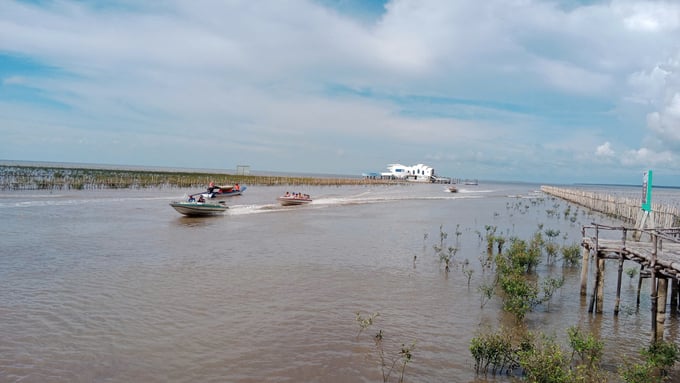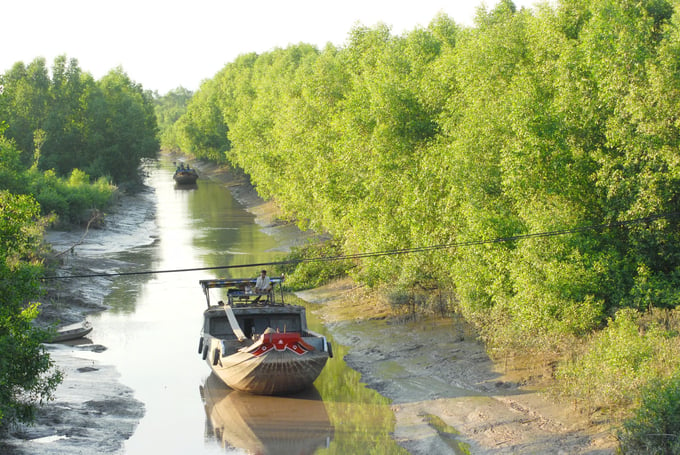November 27, 2025 | 23:58 GMT +7
November 27, 2025 | 23:58 GMT +7
Hotline: 0913.378.918
November 27, 2025 | 23:58 GMT +7
Hotline: 0913.378.918
The coverage area of three major coastal ecosystems - mangrove forests, salt marshes, and seagrass meadows - within the Exclusive Economic Zones (EEZs) of each nation is calculated. This calculation is based on global spatial datasets. These datasets are then combined with the average annual carbon sequestration rates for mangroves, salt marshes, and seagrass meadows, respectively. This combination allows for the estimation of the potential for blue carbon sequestration in each country’s coastal ecosystems.

Mangrove forests not only create rich coastal ecosystems but also serve as massive carbon sinks. Photo: Hai Nam.
The global synthesis of these calculations results in an average sequestration potential of 24 million tons of carbon per year for mangrove forests, 13 million tons per year for salt marshes, and 43 million tons per year for seagrass meadows, summing up to more than 80 million tons per year for all blue carbon ecosystems combined.
These figures align with previous global estimates for mangrove forests and salt marshes, but are somewhat lower for seagrass meadows.
Australia, the United States, and Indonesia are the top three countries with the largest annual carbon sequestration potential, as summarized across all three types of blue carbon ecosystems. Among the countries considered the weakest in terms of blue carbon ecosystems, the smallest annual carbon sequestration potentials are found in Mauritania (2.4 tons of carbon per year), Bulgaria (77 tons of carbon per year), and Saint Vincent and the Grenadines (81 tons of carbon per year).

Livelihood diversity in mangrove forests in Vietnam. Photo: Hai Nam.
The absolute carbon sequestration potential of a country is closely linked to both the length of its coastline and the size of its Exclusive Economic Zone (EEZ).
In terms of global contribution to carbon sequestration, the three countries with the largest annual carbon sequestration potential are Australia, the United States, and Indonesia. These nations not only have vast stretches of coastline but also possess some of the largest EEZs in the world. In particular, Asian countries tend to have significant carbon sequestration potential, largely due to the extensive coverage of coastal blue carbon ecosystems, such as mangrove forests and seagrass meadows, which are predominant in tropical and subtropical regions. These nations, despite having varying sizes of Exclusive Economic Zones (EEZs), benefit from the natural richness of their coastal ecosystems.
On the other hand, many European countries typically exhibit lower carbon sequestration potential, mainly due to smaller areas of coastal ecosystems. However, exceptions to this general trend exist, notably in the case of France and the United Kingdom. These two countries achieve a substantial proportion of their annual carbon sequestration potential - 66% for France and 42% for the UK - through their overseas territories.
France, in particular, leads in terms of the absolute contribution from its overseas territories, with an estimated 0.67 million tons of carbon sequestered per year. The United States follows with 0.56 million tons annually, although this only represents 7.4% of the country’s total annual sequestration potential. When considering the global picture, overseas territories together contribute just 1.7% of the total annual carbon sequestration potential.
The differences observed between countries can be explained not only by variations in the size and location of coastlines but also by the differing efforts made in ecosystem sampling across various regions, as reflected in the spatial data regarding the extent of these ecosystems used for analysis. For instance, the extent of tidal marshes has been comprehensively documented for countries such as Canada, Europe, the United States, South Africa, and Australia, while there is still limited data available for northern Russia and South America, particularly in relation to tidal wetlands and coastal ecosystems in these areas.
In addition to this, the spatial data for seagrass meadows is geographically and historically biased, reflecting an imbalance in research efforts between regions. Furthermore, the regional differences in sequestration potential can also be attributed to varying levels of environmental disturbance and degradation. For example, seagrass meadows in industrialized nations are often significantly affected by eutrophication, pollution, and rapid coastal development. On the other hand, seagrass ecosystems in less developed regions, where water quality is generally better.
Blue carbon is defined by Nature as the organic carbon captured and stored by ocean and coastal ecosystems. According to the Blue Carbon Initiative, coastal habitats cover 2 percent of the ocean’s surface but store 50 percent of the carbon in their sediments - a 75-gigaton carbon sink, equivalent to eight years of fossil fuel-related CO₂ emissions. These ecosystems are under threat: Between 25 and 50 percent of coastal habitats have disappeared in the past century, according to the Intergovernmental Panel on Climate Change. Unlocking financing for this specific niche of carbon credits could be key to saving these habitats.
Translated by Phuong Linh

(VAN) On November 27, in the meeting with Minister Tran Duc Thang, Mayor Yin Yong shared Beijing’s experience to improve environment and air quality.

(VAN) After 30 years, both sides identified strategic areas of cooperation: sustainable production, increasing coffee value and training for farmers.
/2025/11/27/4910-4-164708_294.jpg)
(VAN) On the afternoon of November 27 in Beijing, Minister of Agriculture and Environment Tran Duc Thang held a working session with several major Chinese enterprises operating in the agriculture and environment sector.

(VAN) The Department of Animal Health issued a provisional guideline requesting local authorities to increase surveillance, collect samples for testing, and conduct epidemiological investigations according to the established procedure.

(VAN) The United Nations recommends that Vietnam utilize data and artificial intelligence to enhance early disaster warnings and reduce GDP losses by 3.2% in the context of climate change.

(VAN) On the morning of November 27 in Beijing, Minister Tran Duc Thang and the Deputy Commissioner General of the General Administration of Customs of China signed a protocol on fresh jackfruit exports.

(VAN) As floodwaters recede, a vast network of irrigation works across eastern Gia Lai is emerging in a state of severe disrepair, with extensive damage demanding urgent restoration ahead of the 2025-2026 winter-spring cropping season.